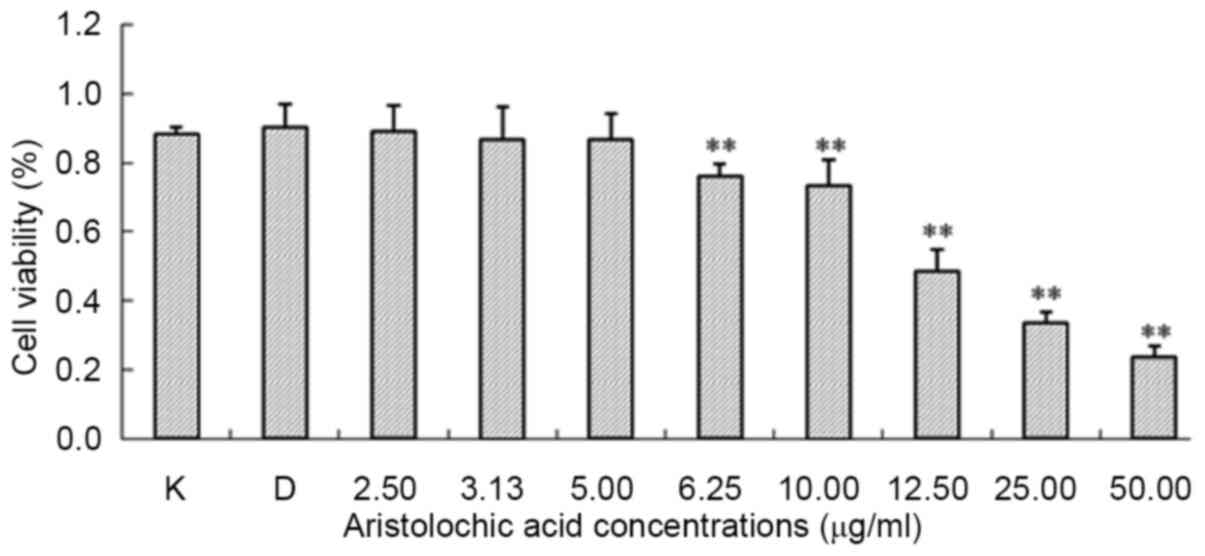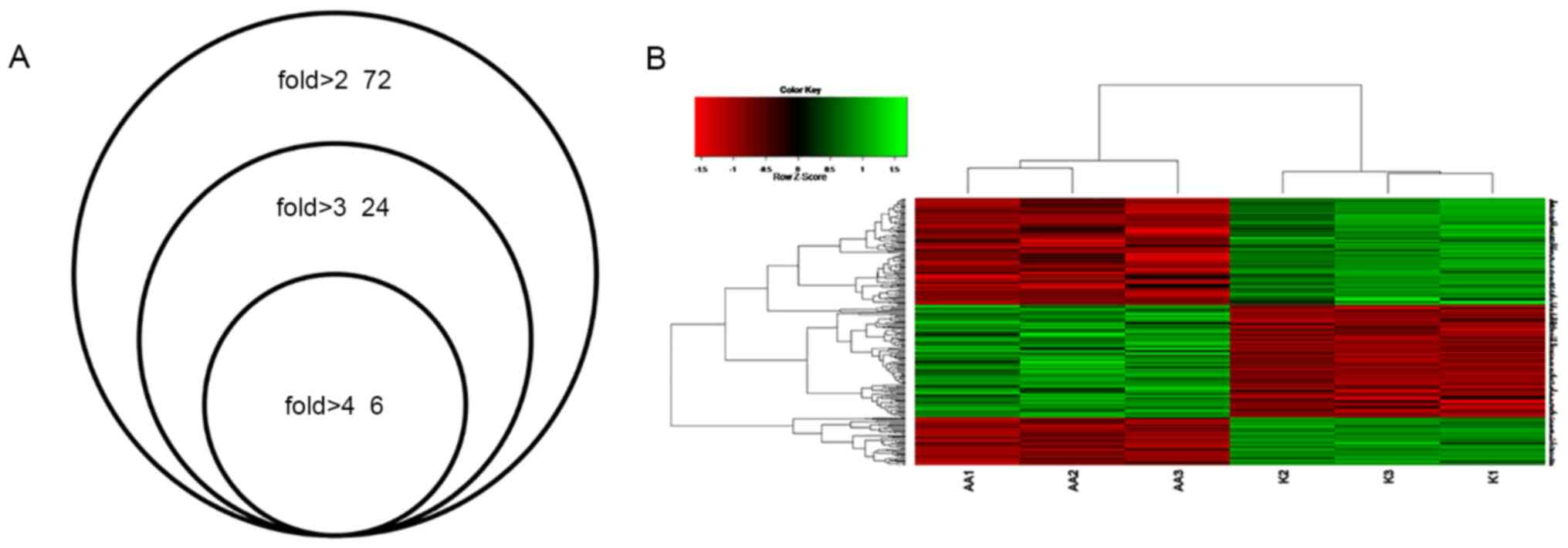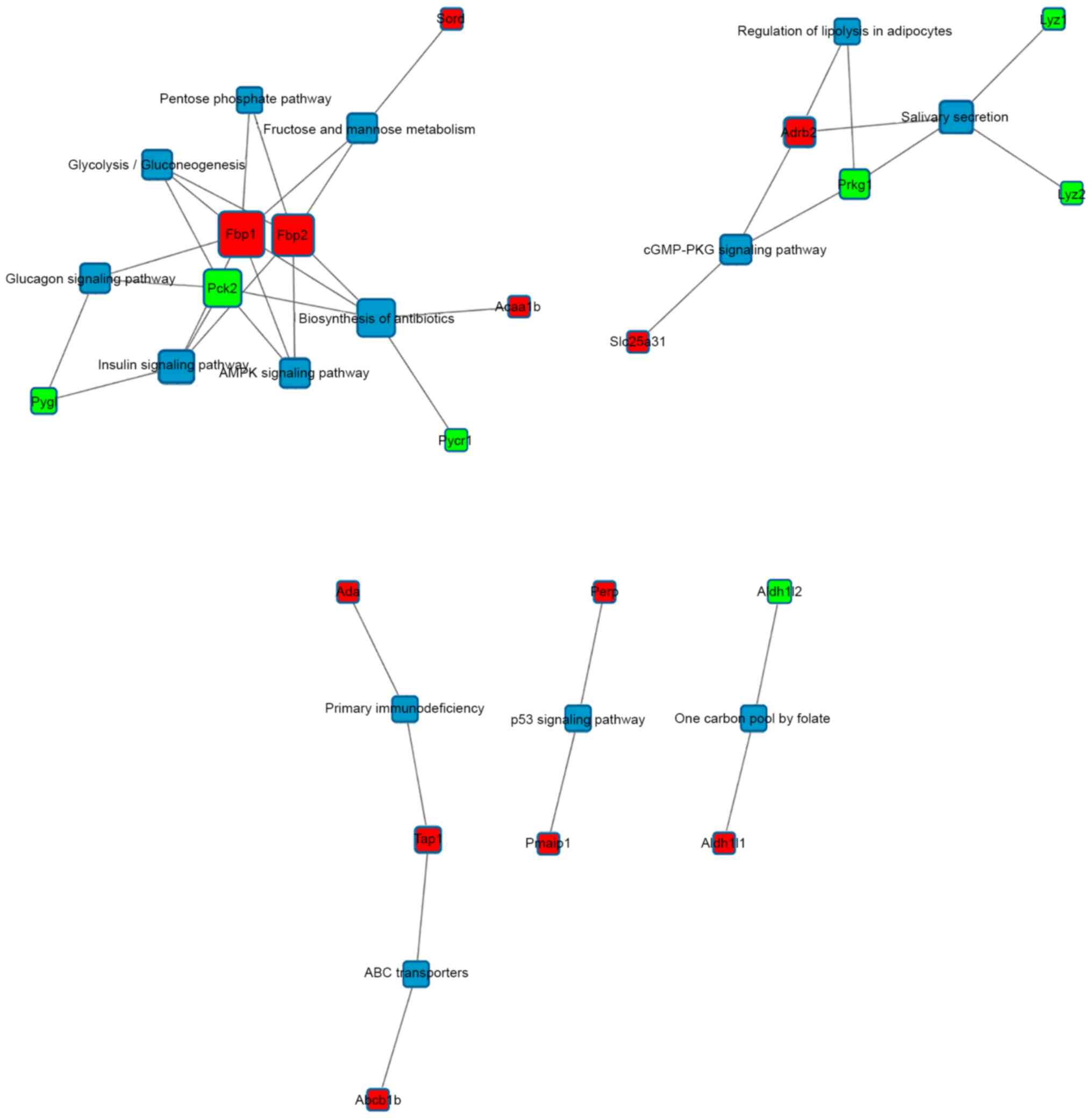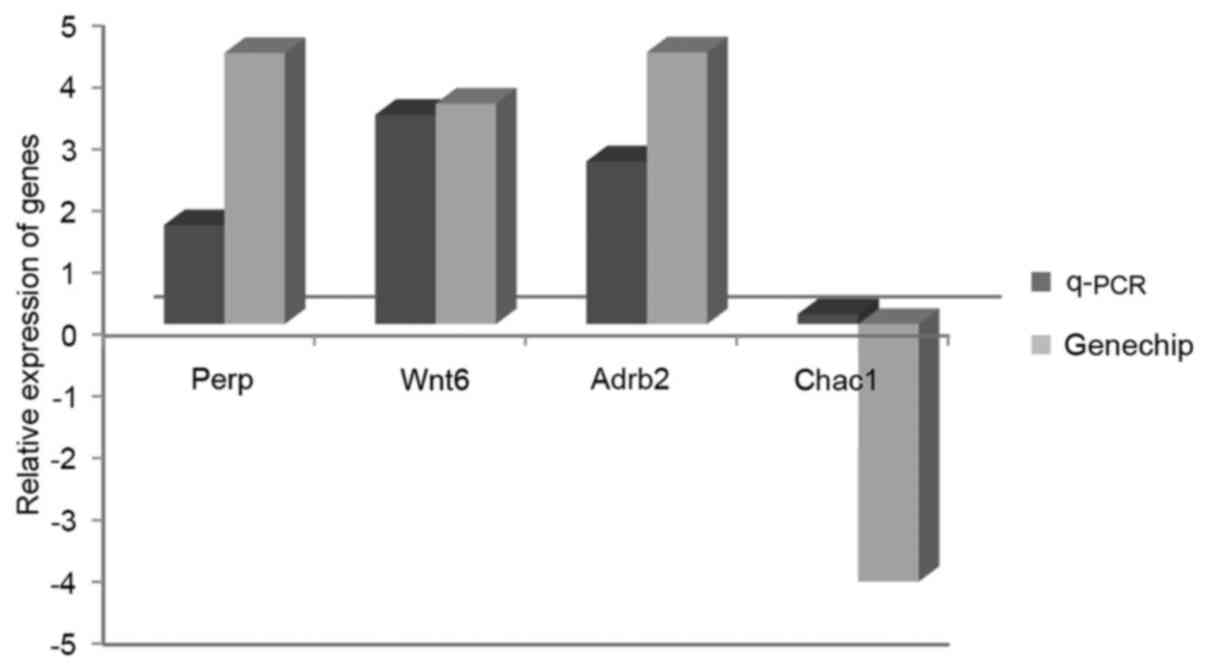|
1
|
Yun KY, Xu ZU and Song JY: Traditional
Chinese medicine containing aristolochic acids and their detection.
Sci Sin Vitae. 49:238–249. 2019.
|
|
2
|
Kuo PC, Li YC and Wu TS: Chemical
constituents and pharmacology of the aristolochia (mădōu ling)
species. J Tradit Complement Med. 2:249–266. 2012.PubMed/NCBI View Article : Google Scholar
|
|
3
|
Li J and Zhang L, Jiang Z, Shu B, Li F,
Bao Q and Zhang L: Toxicities of aristolochic acid I and
aristololactam I in cultured renal epithelial cells. Toxicol In
Vitro. 24:1092–1097. 2010.PubMed/NCBI View Article : Google Scholar
|
|
4
|
Honarpisheh M, Foresto-Neto O, Steiger S,
Kraft F, Koehler P, von Rauchhaupt E, Potempa J, Adamowicz K,
Koziel J and Lech M: Aristolochic acid I determine the phenotype
and activation of macrophages in acute and chronic kidney disease.
Sci Rep. 8(12169)2018.PubMed/NCBI View Article : Google Scholar
|
|
5
|
Yang L, Li X and Wang H: Possible
mechanisms explaining the tendency towards interstitial fibrosis in
aristolochic acid-induced acute tubular necrosis. Nephrol Dial
Transplant. 22:445–456. 2007.PubMed/NCBI View Article : Google Scholar
|
|
6
|
Debelle FD, Vanherweghem JL and Nortier
JL: Aristolochic acid nephropathy: A worldwide problem. Kidney Int.
74:158–169. 2008.PubMed/NCBI View Article : Google Scholar
|
|
7
|
Chen D, Tang Z, Luo C, Chen H and Liu Z:
Clinical and pathological spectrums of aristolochic acid
nephropathy. Clin Nephrol. 78:54–60. 2012.PubMed/NCBI View
Article : Google Scholar
|
|
8
|
Bastek H, Zubel T, Stemmer K, Mangerich A,
Beneke S and Dietrich DR: Comparison of aristolochic acid I derived
DNA adduct levels in human renal toxicity models. Toxicology.
420:29–38. 2019.PubMed/NCBI View Article : Google Scholar
|
|
9
|
Fuchs TC and Hewitt P: Biomarkers for
drug-induced renal damage and nephrotoxicity-an overview for
applied toxicology. AAPS J. 13:615–631. 2011.PubMed/NCBI View Article : Google Scholar
|
|
10
|
Mori Y, Kondo C, Tonomura Y, Torii M and
Uehara T: Identification of potential genomic biomarkers for early
detection of chemically induced cardiotoxicity in rats. Toxicology.
271:36–44. 2010.PubMed/NCBI View Article : Google Scholar
|
|
11
|
Pal R, Mamidi MK, Das AK and Bhonde R:
Human embryonic stem cell proliferation and differentiation as
parameters to evaluate developmental toxicity. J Cell Physiol.
226:1583–1595. 2011.PubMed/NCBI View Article : Google Scholar
|
|
12
|
Ahuja YR, Vijayalakshmi V and Polasa K:
Stem cell test: A practical tool in toxicogenomics. Toxicology.
231:1–10. 2007.PubMed/NCBI View Article : Google Scholar
|
|
13
|
Cezar GG, Quam JA, Smith AM, Rosa GJ,
Piekarczyk MS, Brown JF, Gage FH and Muotri AR: Identification of
small molecules from human embryonic stem cells using metabolomics.
Stem Cells Dev. 16:869–882. 2007.PubMed/NCBI View Article : Google Scholar
|
|
14
|
Asaba A, Okabe S, Nagasawa M, Kato M,
Koshida N, Osakada T, Mogi K and Kikusui T: Developmental social
environment imprints female preference for male song in mice. PLoS
One. 9(e87186)2014.PubMed/NCBI View Article : Google Scholar
|
|
15
|
Fagundez CB, Loresi MA, Ojea Quintana ME,
Delcourt SM, Testa R, Gogorza SJ and Argibay PF: A simple approach
for mouse embryonic stem cells isolation and differentiation
inducing embryoid body formation. Cell Biol Int. 33:1196–1200.
2009.PubMed/NCBI View Article : Google Scholar
|
|
16
|
West PR, Weir AM, Smith AM, Donley EL and
Cezar GG: Predicting human developmental toxicity of
pharmaceuticals using human embryonic stem cells and metabolomics.
Toxicol Appl Pharmacol. 247:18–27. 2010.PubMed/NCBI View Article : Google Scholar
|
|
17
|
Li C and Wing H: DNA-Chip Analyzer
(dChip). The analysis of gene expression data: Methods and
software. Parmigiani G, Garrett ES, Irizarry R and Zeger SL (eds).
Springer, New York, pp120-141, 2003.
|
|
18
|
Livak KJ and Schmittgen TD: Analysis of
relative gene expression data using real-time quantitative PCR and
the 2(-Delta Delta C(T)) method. Methods. 25:402–408.
2001.PubMed/NCBI View Article : Google Scholar
|
|
19
|
Mei N, Arlt VM, Phillips DH, Heflich RH
and Chen T: DNA adduct formation and mutation induction by
aristolochic acid in rat kidney and liver. Mutat Res. 602:83–91.
2006.PubMed/NCBI View Article : Google Scholar
|
|
20
|
De Broe ME, Curhan GC and Forman JP:
Nephropathy induced by aristolochic acid (AA) containing herbs.
UpToDate, 2018.
|
|
21
|
Singaravelu K, Devalaraja-Narashimha K,
Lastovica B and Padanilam BJ: PERP, a p53 proapoptotic target,
mediates apoptotic cell death in renal ischemia. Am J Physiol Renal
Physiol. 296:F847–F858. 2009.PubMed/NCBI View Article : Google Scholar
|
|
22
|
Singaravelu K and Padanilam B: The role of
p53 pro-apoptotic target, PERP, induces mitochondrial permeability
and apoptosis in hypoxic renal cells. FASEB J. 22 (1
Suppl)(730.11)2008.PubMed/NCBI View Article : Google Scholar
|
|
23
|
Lord GM, Hollstein M, Arlt VM, Roufosse C,
Pusey CD, Cook T and Schmeiser HH: DNA adducts and p53 mutations in
a patient with aristolochic acid-associated nephropathy. Am J
Kidney Dis. 43:e11–e17. 2004.PubMed/NCBI View Article : Google Scholar
|
|
24
|
Schimmack G, Defronzo RA and Musi N:
AMP-activated protein kinase: Role in metabolism and therapeutic
implications. Diabetes Obes Metab. 8:591–602. 2006.PubMed/NCBI View Article : Google Scholar
|
|
25
|
Shi L, He C, Li Z, Wang Z and Zhang Q:
FBP1 modulates cell metabolism of breast cancer cells by inhibiting
the expression of HIF-1α. Neoplasma. 64:535–542. 2017.PubMed/NCBI View Article : Google Scholar
|
|
26
|
Kępka A, Dariusz Szajda S, Stypułkowska A,
Waszkiewicz N, Jankowska A, Chojnowska S and Zwierz K: Urinary
fructose-1, 6-bisphosphatase activity as a marker of the damage to
the renal proximal tubules in children with idiopathic nephrotic
syndrome. Clin Chem Lab Med. 46:831–835. 2008.PubMed/NCBI View Article : Google Scholar
|
|
27
|
Kepka A, Szajda SD and Zwierz K:
Fructose-1, 6-bisphosphatase-marker of damage to proximal renal
tubules. Pol Merkur Lekarski. 24:125–130. 2008.PubMed/NCBI View Article : Google Scholar : (In Polish).
|
|
28
|
Upadhyaya Y, Xie L, Salama P, Cao S, Nho
K, Saykin AJ and Yan J: For The Alzheimer's Disease Neuroimaging
Initiative. Differential co-expression analysis reveals early stage
transcriptomic decoupling in alzheimer's disease. BMC Med Genomics.
13 (Suppl 5)(S53)2020.PubMed/NCBI View Article : Google Scholar
|
|
29
|
Hsin YH, Cheng CH, Tzen JT, Wu MJ, Shu KH
and Chen HC: Effect of aristolochic acid on intracellular calcium
concentration and its links with apoptosis in renal tubular cells.
Apoptosis. 11:2167–2177. 2006.PubMed/NCBI View Article : Google Scholar
|
|
30
|
Itäranta P, Lin Y, Peräsaari J, Roël G,
Destrée O and Vainio S: Wnt-6 is expressed in the ureter bud and
induces kidney tubule development in vitro. Genesis. 32:259–268.
2002.PubMed/NCBI View Article : Google Scholar
|
|
31
|
Crawford RR, Prescott ET, Sylvester CF,
Higdon AN, Shan J, Kilberg MS and Mungrue IN: Human CHAC1 protein
degrades glutathione, and mRNA induction is regulated by the
transcription factors ATF4 and ATF3 and a bipartite ATF/CRE
regulatory element. J Biol Chem. 290:15878–15891. 2015.PubMed/NCBI View Article : Google Scholar
|
|
32
|
Choi YM, Cho HY, Anwar MA, Kim HK, Kwon JW
and Choi S: ATF3 attenuates cyclosporin A-induced nephrotoxicity by
downregulating CHOP in HK-2 cells. Biochem Biophys Res Commun.
448:182–188. 2014.PubMed/NCBI View Article : Google Scholar
|


















